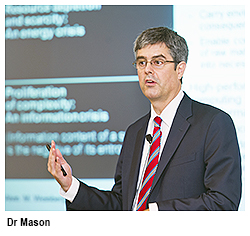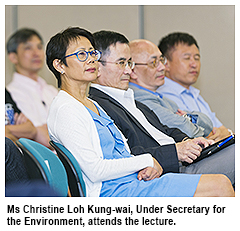Science technology for the energy challenge
In his lecture at City University of Hong Kong (CityU) on 15 September, Dr Thomas Mason, Director of the Oak Ridge National Laboratory in the US Department of Energy, addressed one of the most pressing questions of our modern era: how will we secure safe and reliable sources of energy that enable more people to enjoy a higher standard of living?
Dr Mason was speaking at the latest talk in the CityU Distinguished Lecture series. He began by pointing out that the demand for energy will inexorably grow as people aspire to a better way of life.
“Our standard of living is exactly tied to our per capita energy consumption,” he said. “As you get wealthier, you consume more energy: you use it to heat and cool your homes, you use it to travel; you use it to produce the comforts of modern life.”
Yet a large fraction of the world currently has limited or no access to energy—up to 1.5 billion people do not even have access to electricity. Problems of scarcity, he said, can be tied into energy.
However, producing more energy from fossil fuels carries environmental impacts, such as ecological threats from damming rivers and emissions from carbon dioxide, sulphur oxides and nitrogen oxides. There are also security concerns with the production of fossil fuels in areas such as the Middle East and Ukraine, which are experiencing conflict.
As growing numbers of people become wealthier, Dr Mason said that we would face a serious shortfall in energy production. How will we make up that shortfall? And how will we minimise the emissions that are associated with climate change?
One way Dr Mason suggested is to find new supplies of fossil fuels and improve the ways we use them. As fossil fuels will continue to be in use for at least another 100 years, we must break the link between fossil fuels and carbon dioxide emissions. If we did not break this link, he said, we would have to deal with the serious risks of climate change, including rising sea-levels, extreme weather events, and even health and security impacts due to forced migrations and the increased cost of food production.
The greatest contribution to carbon dioxide reduction will come from improving energy-use efficiency. High-efficiency appliances and vehicles, along with improvements in the power distribution system, are just a few examples that are already leading to reductions in carbon dioxide levels.
Dr Mason also proposed three alternatives: nuclear power; renewable energy sources such as solar, biomass and wind; and fusion power. Around nuclear energy, however, there are questions of safety and social acceptance, and even fusion scientists are not sure if this new technology will actually work.
Renewables also have their own issues in terms of land use, intermittent supply and competition with food crops, especially in the case of biofuels.
Dr Mason concluded that the technology with the greatest potential to provide a safe, reliable and unlimited source of energy is solar, although work still needs to be done to make it more affordable and practical. “In terms of energy supply,” said Dr Mason, “solar could take care of the whole problem.”
Nevertheless, no one form of energy offers a total solution and each has its own set of environmental challenges. Solar, wind, biofuels, nuclear power, fusion and fossil fuels all have both positive and negative impacts.
“The question in the end,” said Dr Mason, “is how you mitigate and minimise the bad social consequences associated with energy production — you will never eliminate them — in order to enjoy the social benefits of energy use.”



